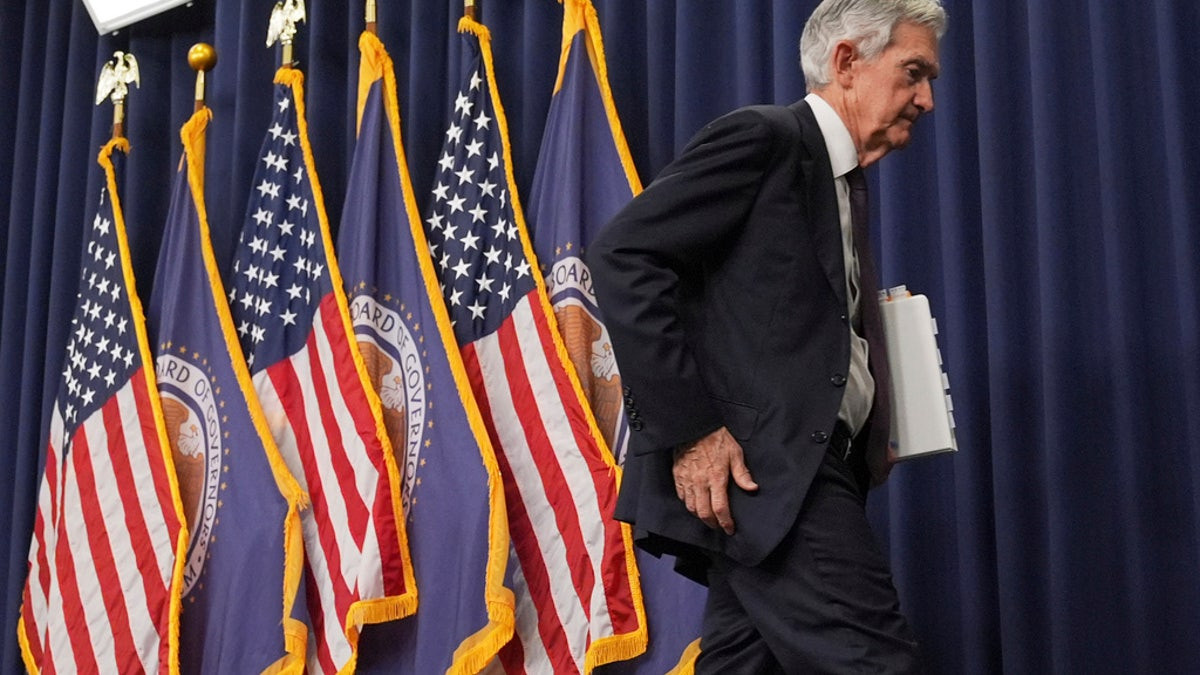
NEWYou can now listen to Fox News articles!
Last Friday in Jackson Hole, Federal Reserve Chairman Jay Powell finally – and grudgingly – admitted what the Trump team has been saying all along: tariffs don’t fuel inflation.
At most, tariffs create a one-time adjustment in prices, not the kind of runaway spiral that demands punishing rate hikes. And even that one-time bump may be negligible if, as we have long argued, foreign exporters – not American consumers – shoulder most or all of the burden.
The implication is clear: whether the impact is zero or merely a one-time step-up in prices, there is absolutely no justification for the Fed to hide behind “tariff uncertainty” as an excuse for overly restrictive interest-rate policy.

Federal Reserve Chairman Jerome Powell walks off following a news conference, May 7, 2025, at the Federal Reserve in Washington. (AP Photo/Jacquelyn Martin)
This really is a historic epiphany from a Fed chair who has long misunderstood the power of Trumpnomics – the four beautiful horsemen of economic growth and price stability: tax cuts, deregulation, strategic energy dominance and fair trade.
THE FED’S FOOLISH INTEREST RATE POLICY IS STOPPING AMERICA’S ECONOMY FROM BOOMING
Trumpnomics delivered both strong economic growth and price stability in the first term. It is delivering again in the second.
Markets immediately recognized the punch of Powell’s tariff epiphany. The Dow smashed through its 45,000 ceiling – and I remain on record predicting a march to 50,000. Yields on the 10- and 30-year Treasuries tumbled, driving bond prices sharply higher.
Clearly, Wall Street got Powell’s dovish tariff message: the door to a September rate cut is now wide open. The only suspense is whether Powell will nibble with 25 basis points – or cut far more boldly.
But here’s the lingering fear, from the West Wing to Wall Street: While Powell may now grasp that tariffs don’t fuel persistent inflation, he still doesn’t understand who pays.
GOOD ECONOMIC DATA IS BAD NEWS FOR TRUMP’S INTEREST RATE PUSH
Memo to Jay: Every one of America’s major trading partners – the same countries driving our $1 trillion annual trade deficit – is deeply dependent on access to the U.S. market. When Trump slaps on tariffs, it is their exporters, not our consumers, who shoulder the burden. Without U.S. demand, their economies falter – so pay the tariff piper our trading partners must.
That’s why in Trump’s first term, despite all the handwringing from the “Panicans” about looming inflation, tariffs on everything from steel and aluminum to China produced the opposite: robust growth with price stability.
If Powell clings to timidity and keeps rates overly restrictive, he will continue inflicting enormous harm on the U.S. economy. American families are already being crushed by the world’s highest mortgage rates, small businesses can’t get affordable credit, and exporters face a dollar so overvalued it prices them out of global markets.
Global rate spreads underscore just how out of touch the Fed is with the rest of the world. The European Central Bank’s deposit facility sits at 2%. The Bank of Japan holds near 0.5%. China runs its seven-day repo at 1.4%. Against that backdrop, the Fed’s 4.25%–4.50% target range remains a glaring outlier – more than 200 basis points above Europe, nearly 400 above Japan, and triple China.
LEFT’S TARIFF DOOMSDAY PREDICTIONS FALL FLAT AS TRUMP’S AMERICA THRIVES
The result: the U.S. economy combines the world’s highest policy rates and mortgage rates with the world’s strongest currency – a triple hit to American exporters.
On the home front, the Powell squeeze is just as punishing. Average 30-year fixed mortgage rates remain stuck in the 6–7% range, double pre-pandemic levels. That locks millions of young families out of the housing market and stalls residential construction — historically one of the most powerful engines of U.S. recoveries.
Small businesses, reliant on bank credit rather than Wall Street bond markets, face double-digit loan rates that suffocate job creation. Consumers pay more on everything from credit cards to auto loans.
CLICK HERE FOR MORE FOX NEWS OPINION
And for what? Disinflation is already here. Headline CPI is back near 3% year-on-year. The Fed’s preferred PCE measure runs closer to 2.5% – essentially on target. Energy prices are subdued, supply chains have healed, and wage pressures are stabilizing. Yet U.S. real (inflation-adjusted) rates now stand higher than at any point in nearly two decades – a textbook case of over-tightening.
Powell defends this stance by claiming the Fed must “anchor inflation expectations.” He has clutched his pearls over the mirage of tariff-driven inflation, even as history shows those fears are overblown.
Powell’s Jackson Hole admission – that tariffs create, at most, a one-time price adjustment – was an epiphany long in coming. The question now is whether Powell will act on that epiphany.
CLICK HERE TO GET THE FOX NEWS APP
A token 25-basis-point trim in September would not cut it. To realign America with its global peers, to relieve pressure on families and farmers, and to restore competitiveness to U.S. exporters, the Fed must move decisively with an up to a 100 basis point cut.
It’s time for the Federal Reserve to stop mistaking tight money for prudence. Keeping U.S. rates far above the rest of the world is not a sign of strength. It is a policy mistake – one that strangles American growth and hands our competitors the advantage.

![Enjoy the [Road] Show Travel Mug with Handle, 14ozEnjoy the [Road] Show Travel Mug with Handle, 14oz](https://georgemagazine.com/wp-content/uploads/2024/08/479070202831754764_2048-300x300.jpeg)

